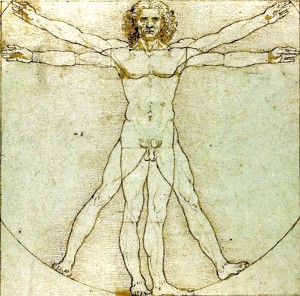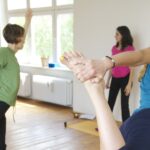Many people discover Yoga during the process of trying to treat back pain. Back pain is a very common problem in our society and can be caused by diverse sources. It can stem from simple muscle tightness, chronic postural problems, bad working conditions, structural misalignment in the skeleton, emotional stress or any number of other imbalances in the body. 
A regular, personalized Yoga practice can go a long way in helping to relieve back pain. We are careful to keep our Berlin Yoga classes small enough so that every student can freely ask questions about their own body. It’s important that your practice is tailored to suit your needs–every back is different! Make sure that you let your teacher know about your specific issues. For example, Yoga for a slipped disc is very different from Yoga for tight hamstrings.
Here are some tips for using Yoga to treat the most common back ailments.
Downward Dog is a wonderful posture for strengthening all of the paraspinal muscles. It also helps to stretch the hamstrings and calves, which, when tense, can contribute to lordosis in the lumbar spine. It’s very important to have a straight back as you practice Downward Dog–so start with bent knees and, as your legs warm up, you can experiment with straightening them. Sliding the shoulder blades down the back and rotating the upper arms outwards will keep your shoulders broad and strong in the pose.
Cat/Cow is a gentle vinyasa that helps the spine warm up and releases tension in the back. Make sure you move slowly, deliberately and with your breath. If you have neck problems, keep your neck steady and your gaze on the floor. Otherwise, you can let it move with the rest of your spine. As your back warms up, notice where the bend is easiest to accomplish in your spine and then gently bring the movement into the stiffer parts of your back. This will help achieve more mobility in tighter parts of the spine.
Child’s Pose is a great release for the lower back. Bringing your knees together under your belly will bring your spine into neutral. Letting them rest wide apart is a deeper hip opener but involves more flexibility in the lower spine. Choose whichever variation works best for you, rest your forehead on a block or on the floor and then breathe and relax.
Abdominal Work is best performed while lying on the back. This way, the floor can support the pelvis and the lower back. This makes it easier to work the abdominal muscles without straining the spine and strong, long core muscles are a key part of back health. Start gently, lifting the legs one by one (with the knees bent if need be), and then build gradually towards longer holds.
As always, listen to your body. If you feel any pain, stop, rest and ask for a variation from your teacher.














